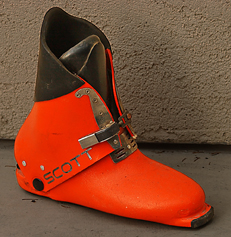As leather succumbed to the superiority of plastic in the 1960s, there was a period of experimentation and innovation that saw many new, now memorable, ski boot designs, such as the Scott boot from the 1970s. (Scott USA was registered in 1958 but is now a Swiss company.)

The visually small ski boot was also light, warm and comfortable, and since it was made with a stiffer plastic, it skied nicely when conditions were good. It was also sensitive, probably due to the rigid plastic used unlike most boots built with a more flexible plastic. But it was the stiffness that made the boot enjoyable to ski in. The Scott boot took some getting used to, but of the dozens of boots I’ve worn over the decades, I still fondly remember my Scotts.
The rigid plastic meant the boot cracked and broke fairly easily, and through repairs it became fashionable to piece together a unique pair of different coloured boots. But the real downside was the fitting system. It consisted of a number of soft parts that compressed to fit. The fit was good but the material continued to compress so the fit changed during the day as well as over the season. Like many other Scott aficionados, I had a bag of spare parts at the ready.
Scott discontinued its boots too soon. It was a new design direction that might have yielded something great, but sadly it was never developed though it seemed like a good idea at the time.



